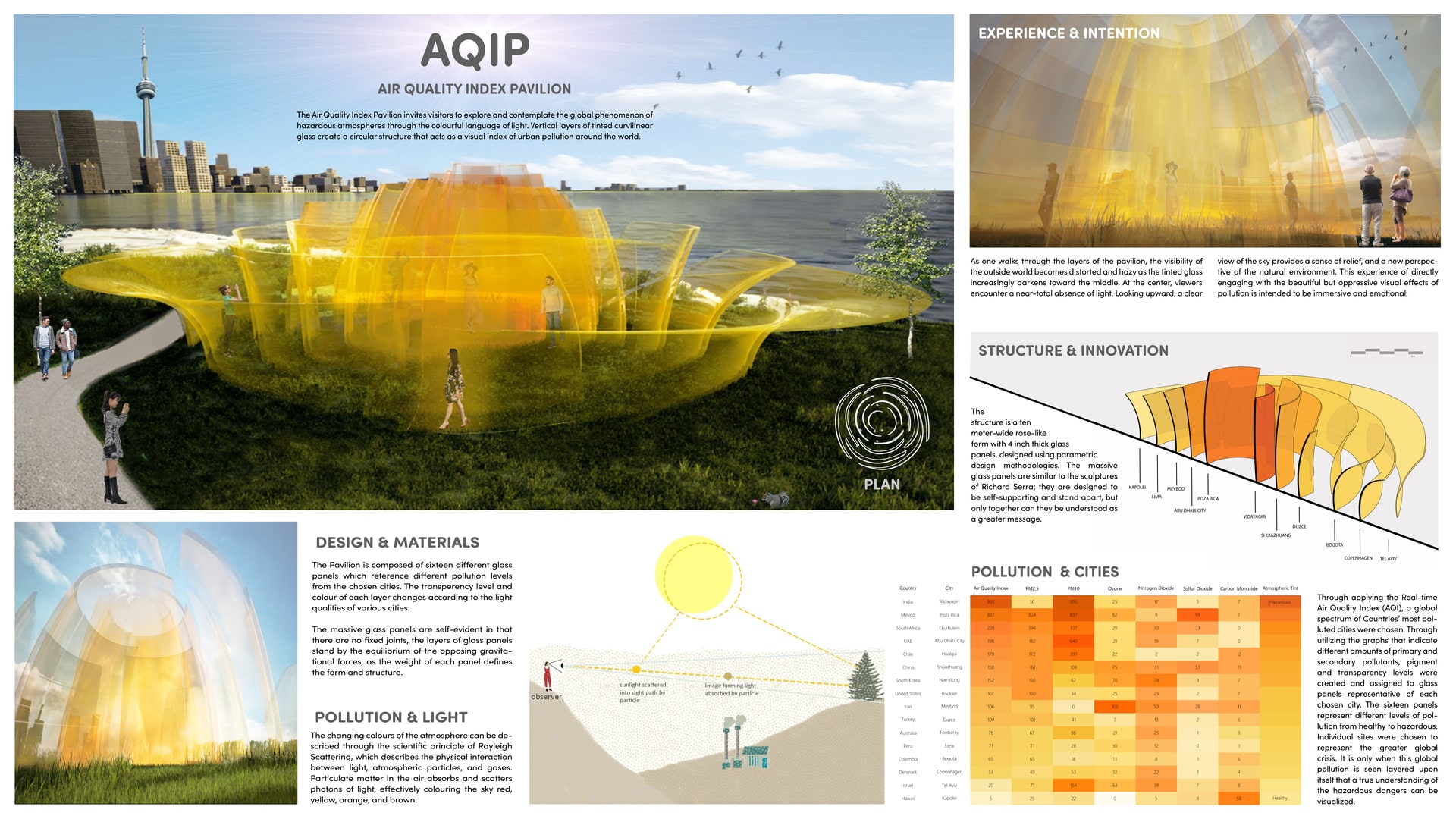Project Description
The tragedy of climate change is that it alters our environment so slowly that we become comfortable with it. We fail to recognize that the whole earth shares a single breath. Upon entering the proposed Air Quality Index Pavilion (AQIP), visitors witness an immediate transformation of natural light as it is filtered through vertical layers of tinted curvilinear glass. Immersed in layers of optically simulated air pollution, visitors are invited to explore and contemplate a global phenomenon of hazardous atmospheres, indexed by the colourful language of light. The quality of life is related to the quality of air. As global cities tackle worsening environmental conditions, the AQIP indicates that the appearance of natural light can provide us with a valuable tool for measuring the hazardous impacts of industry. The structure is a ten meter-wide, rose-like form with 4-inch-thick glass panels, designed using parametric design methodologies. Visitors are encouraged to explore the tall, blooming layers of tinted glass until arriving in the center, where they are visually severed from the outside world. The massive glass panels are similar to the sculptures of Richard Serra; they are designed to be self-supporting and stand apart, but only together can they be understood as a greater message. The indexical representation of cities’ pollution levels is reflected in the pavilion’s layers of various warm tints and transparencies. These colours are derived from real data to visualize the pollution of specific cities chosen to exemplify their country’s worst current air quality. Not only does the Pavilion change the quality of interior light but it allows the visitor to view the outside environment through different filters of global atmospheres. It becomes an experiential map to investigate and connect this global phenomenon. The AQIP allows people to experience different levels of air pollution and make them realize that Pollution has the power to mask the connections between people, even in public spaces. Through applying the Real-time Air Quality Index (AQI), a global spectrum of Countries’ most polluted cities were chosen. Through utilizing the graphs that indicate different amounts of primary and secondary pollutants, pigment and transparency levels were created and assigned to glass panels representative of each chosen city. The sixteen panels represent different levels of pollution from healthy to hazardous. It is only when this global pollution is seen layered upon itself that a true understanding of the greater crisis can be visualized. The AQIP uses the ephemeral language of transparency and natural light to translate scientific, atmospheric effects into a personal experience of this global crisis. The changing colours of the atmosphere can be described through the scientific principle of Rayleigh Scattering, which describes the physical interaction between light, atmospheric particles, and gases. Particulate matter in the air absorbs and scatters photons of light, effectively colouring the sky red, yellow, orange, and brown. This occurs due to the taller, blue wavelengths of light being filtered through gasses in the earth’s natural atmosphere. This yellowing effect, combined with the reddish pollutant NO2, and the brown hue of particulate matter, creates the yellow-orange gradient scale used in the design. This gradient of layered translucent panels aims to reflect the effects of a polluted atmosphere, even to the point where our visibility degrades or is completely obscured at the center of the pavilion. The beautiful hues created by this effect are born from ugly exploitation. As one walks through the layers of the pavilion, the visibility of the outside world becomes distorted and hazy as the tinted glass increasingly darkens toward the middle. At the center, viewers encounter a near-total absence of natural light. Looking upward, a clear view of the sky provides a sense of relief, and a new perspective of the natural environment. This design is inspired by the works of artists James Turrell and Olafur Eliasson, and references the windows of the Hagia Sophia, and the ‘Eye of God’ built into the ceiling of the prison cells in the Eastern State Penitentiary. Toronto is an ideal site for proposed construction, because it is one of the most multicultural cities in the world and has an exceptionally clear atmosphere. This experience of directly engaging with the beautiful but oppressive visual effects of pollution is intended to be immersive and emotional. The AQIP enables visitors to personally visualize the global effects of pollution on the quality of light and visibility as it filters the world surrounding us. Air pollution is a worsening problem that many cities around the globe are tackling as the negative effects on health, aesthetics, and air quality dramatically affect a region’s quality of life. The pavilion acts as a quantified symbol of the industrial effects of global air quality, and as a symbol of opportunity that the world’s communities may come together to return all cities to light.
